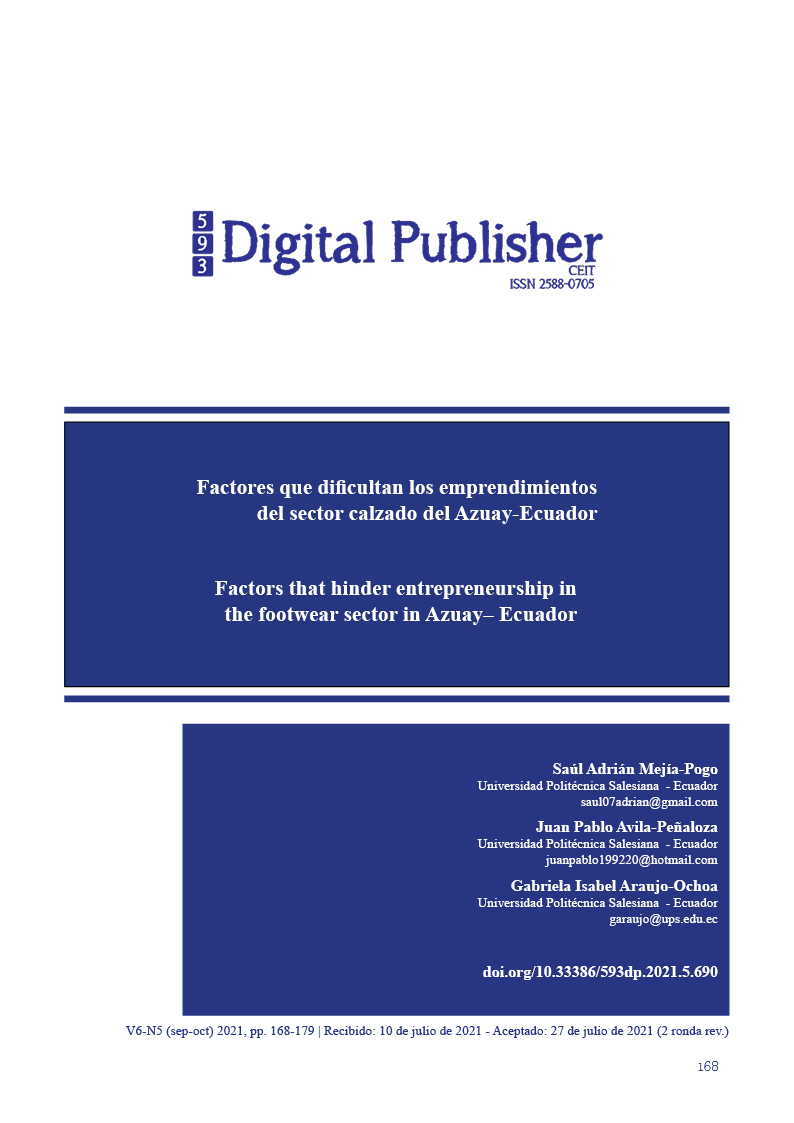Factors that hinder entrepreneurship in the footwear sector in Azuay– Ecuador
Main Article Content
Abstract
The life cycle of enterprises does not exceed the barrier of 3 months to a year, in the different types of economic activity, that is why information must be obtained about the factors that hinder entrepreneurial activity to strengthen weaknesses and mitigate the threats from entrepreneurs, otherwise, the emerging businesses will not be able to be maintained, causing a negative impact both at the family, business and social level. The objective of this article is to find the main and significant early breakdown factors that hinder the entrepreneurial activity of the Azuay footwear sector. The method used for the research is quantitative-qualitative, to quantify the importance of the analyzed factors, additionally, surveys were carried out with footwear producers who are still current in their activity, to know their strengths and weaknesses, and the following survey of a representative group of society, through a convenience sampling and with a finite population of the city of Cuenca, capital of the province of Azuay. A survey consisting of closed questions was conducted to find out their strengths and how undertakings of this type should improve, finding that among the most important factors are investment, financing, government support, legal and market barriers, which are the issues to have special attention and mitigate the effects so as not to fail the ventures, in addition to finding opportunities such as the acceptance of the Azuayan market.
Downloads
Article Details

This work is licensed under a Creative Commons Attribution-NonCommercial-ShareAlike 4.0 International License.
1. Derechos de autor
Las obras que se publican en 593 Digital Publisher CEIT están sujetas a los siguientes términos:
1.1. 593 Digital Publisher CEIT, conserva los derechos patrimoniales (copyright) de las obras publicadas, favorece y permite la reutilización de las mismas bajo la licencia Licencia Creative Commons 4.0 de Reconocimiento-NoComercial-CompartirIgual 4.0, por lo cual se pueden copiar, usar, difundir, transmitir y exponer públicamente, siempre que:
1.1.a. Se cite la autoría y fuente original de su publicación (revista, editorial, URL).
1.1.b. No se usen para fines comerciales u onerosos.
1.1.c. Se mencione la existencia y especificaciones de esta licencia de uso.
References
Alcaldía de Gualaceo. (2017). Obtenido de la alcaldia de Gualaceo. Obtenido de http://www.gualaceo.gob.ec/turismo/detalles/Calzado
Banco Central del Ecuador. (Septiembre de 2020). Boletin Septiembre. Obtenido de BCE: https://contenido.bce.fin.ec/home1/estadisticas/bolmensual/IEMensual.jsp
Banco Mundial. (Diciembre de 2012). Doing Business. Obtenido de Midiendo Regulaciones para Hacer negocios: http://espanol.doingbusiness.org/
Barros, C. (19 de Juio de 2015). Innovación y diseño son aún un desafío para el zapato ecuatoriano.
Baumol, W., Litam , R., & Scharmm, C. (2008). Capitalismo Bueno, Capitalismo Malo y la Económia del Crecimiento y Prosperidad.
Bhide R., Sahlman W.A., Stancil J. M., Block Z., MAcmillan I, Rock A., Nevens T., Summe G., Uttal B. (1999). Iniciativa Emprendedora. Barcelona: Ediciones Deusto.
Bravo , C. (2013). Marketing de Guerrilla para Emprendedores Valientes. Madrid: La Esfera de los Libros.
Departamento Nacional de Planificación. (Septiembre de 2006). Agenda Interna Sectorial. Obtenido de Sector Artesanal: www.dnp.gov.co/archivos/documentos/AI_Documentos/artesanías.pdf
Ecuador. (2008). Constitución Política del Ecuador.
Francés, A. (2001). Estrategia para la Empresa en América Latina. IESA.
Giovany, A. (08 de Enero de 2019). Las cooperativas se consolidan dentro del sistema financiero. Obtenido de Revisa Líderes: https://www.revistalideres.ec/lideres/cooperativas-consolidan-sistema-financiero-economia.html#:~:text=Siete%20millones%20de%20personas%20son,restantes%20(medianos%20y%20peque%C3%B1os).
Gomez María, S. K. (2011). Educación en emprendimiento: fortalecimiento de competencias emprendedoras en la Pontificia Universidad Javeriana Cali. Pontificia Universidad Javeriana de Cali.
Guerrero, A., & Gonzalez , P. (2018). Caracterización de la Producción Artesanal del Calzado en el Cantón Gualaceo y su Incidencia en el Desarrollo Económico Social . Polo del Conocimiento.
INEC. (2010). Ecuador en Cifras. Obtenido de Fascículo Provincial del Azuay: https://www.ecuadorencifras.gob.ec/wp-content/descargas/Manu-lateral/Resultados-provinciales/azuay.pdf
José, M. (2016). La innovación como determinante pare el emprendimiento. MPRA Munich.
Krause, M. (2004). Economía para Emprendedores. Buenos Aires: Aguilar.
Lasio, V., Ordeñana, X., Samaniego, A., Caicedo, G., & Izquierdo, E. (2017). GEM Ecuador.
Lester, B. (2001). Enciclopedia del Management. España: Oceano.
Manzanera, A. (2013). Finanzas para Emprendedores. Deusto.
Marta, F. (2004). El concepto de emprendimiento y su relación con el empleo, la educación y el desarrollo local. Conference: VII Congreso Nacional e internacional de Administración, y XI CONAMerco (Congreso de Administración del MERCOSUR)., (pág. 20). Colombia.
Michaell, S. (2010). Estrategia de Negocio. Quito: Ediecuatorial.
MIPRO. (Mayo de 2010). FLACSO - MIPRO. Obtenido de FLACSO - MPRO: https://www.aduana.gob.ec/archivos/Boletines/2015/resolucion_011_2015%20Comex.pdf
Mochon, F., & Bcker , A. (2006). Economía principios y aplicaciones. España.
Palao Jorge, G. V. (2009). Diez Claves Para Ser un Empresario de Exito. Lima: Palao Editores.
Palao Jorge, G. V. (2009). Inicie su Negocio. Lima: Palao Editores.
Parra , P. (2015). Innovación, liquidez y calidad,los retos del calzado en el Ecuador. Revista Gestión.
Plotinsky, D. (2015). La Económia Social y Solidaria en la Historia de América Latina y el Caribe. Buenos Aires: Idelcoop.
Quituisaca-león, A., Ruilova-Morocho, R., & Araujo-Ochoa, G. (2021). Continuidad de las MiPymes bajo la norma ISO 22301. Caso Cuenca - Azuay. 593 Digital Publisher CEIT, 6 (2), 30-42.
Ries, A., & Ries, L. (2000). 22 Leyes Inmutables de la Marca. Mc Graw Hill.
Ries, E. (2018). El Método Lean Starup. Deusto.
Rodrigo, V. (2001). Innovación Empresarial. Bogota: Pearson Educación de Colombia.
Sapag Chain, N. (2011). Proyecto de inversión. Chile: Person.
Schujman, M. S. (2014). Economía Social y Solidaria. Rosario: DelRevéz.
Schumpeter, J. (1934). The theory of economic development. Harvard University Press.
SENAE. (Marzo de 2015). Salvaguardia. Obtenido de Resolución 011-15: http://www.comercioexterior.gob.ec/wp-content/uploads/2015/03/Resoluci%C3%B3n-011-20151.pdf
SENAE. (Junio de 2017). Productos que ya no Pagan Salvaguadias. Obtenido de SENAE: https://www.aduana.gob.ec/productos-que-ya-no-pagan-salvaguardias/
Tacuri , J., & Rodas, A. (2018). “Determinación y Evaluación de la Sostenibilidad de los Emprendimientos de Calzado en Cuenca y Gualaceo” Trabajo de Titulación. Cuenca, Ecuador.
Trías de Bes, F. (2007). El Libro Negro del Emprendedor, 2da Edición . España: Empresa activa.




